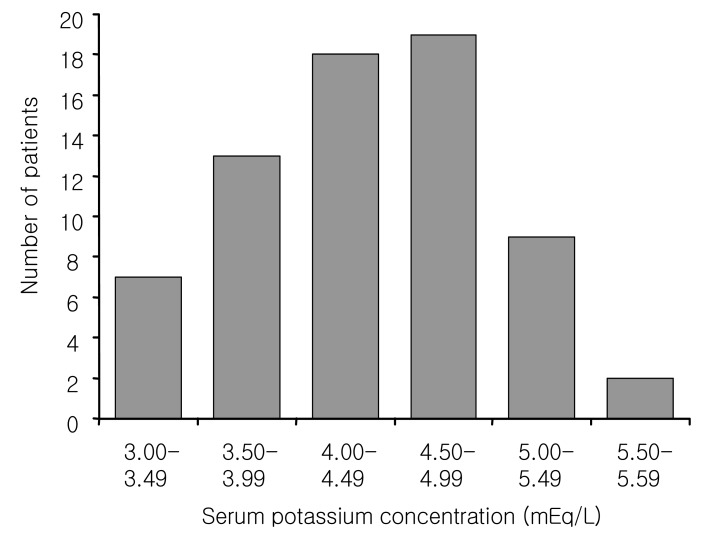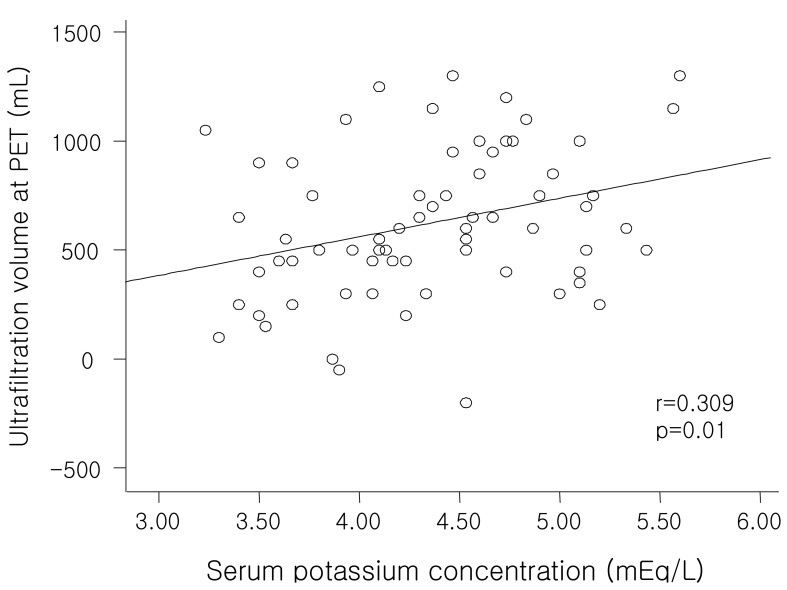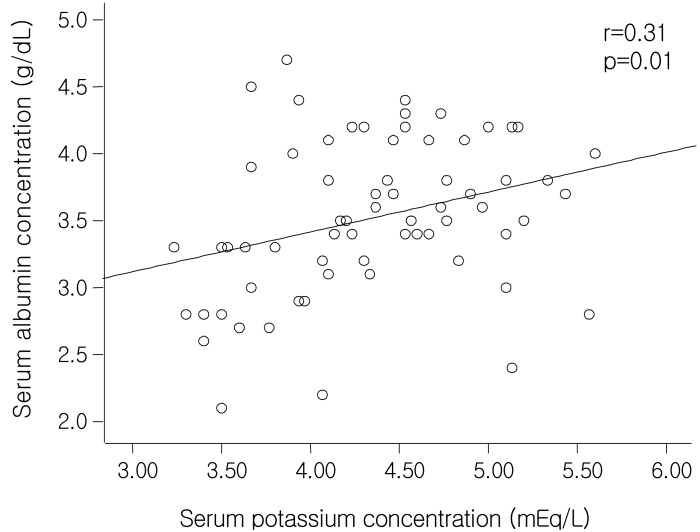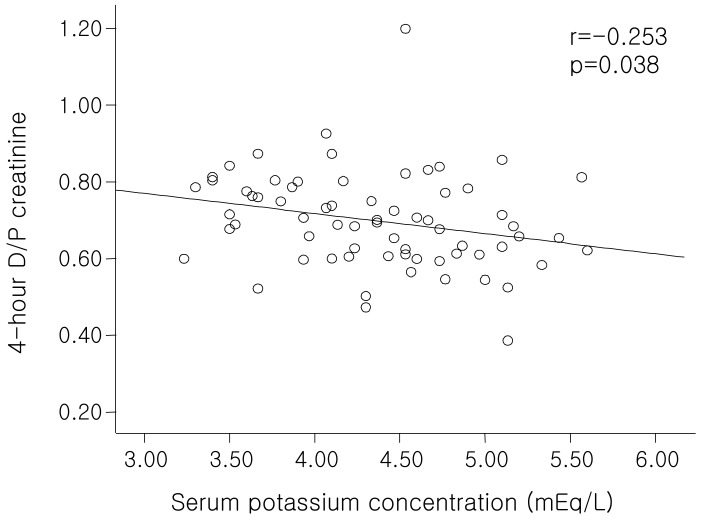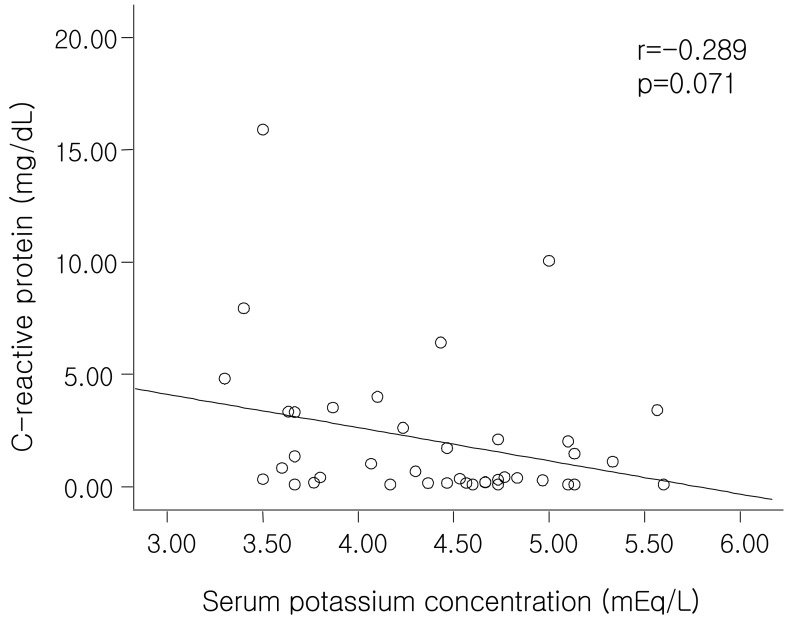Electrolyte Blood Press.
2007 Dec;5(2):102-110. 10.5049/EBP.2007.5.2.102.
Factors associated with Hypokalemia in Continuous Ambulatory Peritoneal Dialysis Patients
- Affiliations
-
- 1Department of Internal Medicine, Yonsei University College of Medicine The Institute of Kidney Disease, Yonsei University, Seoul, Korea. dshan@yuhs.ac
- KMID: 2052292
- DOI: http://doi.org/10.5049/EBP.2007.5.2.102
Abstract
- Hypokalemia is a frequent problem in patients on continuous ambulatory peritoneal dialysis (CAPD) and is affected by multiple factors. To evaluate factors associated with hypokalemia, we studied 68 patients on maintenance CAPD treatment for at least six months. In univariate analysis, patients with hypokalemia were associated with older age and the presence of diabetes mellitus. Serum albumin, calcium-phosphate product, triglyceride, body mass index, protein nitrogen appearance, and lean body mass assessed by creatinine kinetics were significantly lower as compared to those without hypokalemia. Serum C-reactive protein was significantly higher in the patients with hypokalemia. Multivariate stepwise linear regression analysis revealed that the serum albumin level and the ultrafiltration volume at the peritoneal equilibration test were independent factors associated with hypokalemia. This suggests that the serum potassium level may be an important nutritional marker in CAPD patients. Further longitudinal investigation is needed to clarify this relationship.
MeSH Terms
Figure
Cited by 2 articles
-
Icodextrin Improves the Serum Potassium Profile with the Enhancement of Nutritional Status in Continuous Ambulatory Peritoneal Dialysis Patients
Joo-Hark Yi, Jae-Il Park, Hoon-Young Choi, Ho-Yung Lee, Sang-Woong Han, Ho-Jung Kim
Electrolyte Blood Press. 2009;7(2):79-86. doi: 10.5049/EBP.2009.7.2.79.De Novo Hypokalemia in Incident Peritoneal Dialysis Patients: A 1-Year Observational Study
Ji Yong Jung, Jae Hyun Chang, Hyun Hee Lee, Wookyung Chung, Sejoong Kim
Electrolyte Blood Press. 2009;7(2):73-78. doi: 10.5049/EBP.2009.7.2.73.
Reference
-
1. Khan AN, Bernardini J, Johnston JR, Piraino B. Hypokalemia in peritoneal dialysis patients. Perit Dial Int. 1996; 16:652. PMID: 8981546.
Article2. Szeto CC, Chow KM, Kwan BC, Leung CB, Chung KY, Law MC, Li PK. Hypokalemia in Chinese peritoneal dialysis patients: prevalence and prognostic implication. Am J Kidney Dis. 2005; 46:128–135. PMID: 15983966.
Article3. Wang Z, Zhu S, Wang J, Pierson RN Jr, Heymsfield SB. Whole-body skeletal muscle mass: development and validation of total-body potassium prediction models. Am J Clin Nutr. 2003; 77:76–82. PMID: 12499326.
Article4. Keshaviah PR, Nolph KD, Moore HL, Prowant B, Emerson PF, Meyer M, Twardowski ZJ, Khanna R, Ponferrada L, Collins A. Lean body mass estimation by creatinine kinetics. J Am Soc Nephrol. 1994; 4:1475–1485. PMID: 8161729.
Article5. Bergstrom J, Furst P, Alvestrand A, Lindholm B. Protein and energy intake, nitrogen balance and nitrogen losses in patients treated with continuous ambulatory peritoneal dialysis. Kidney Int. 1993; 44:1048–1057. PMID: 8264134.6. Twardowski ZJ, Nolph KD, Khanna R, Prowant BF, Ryan LP, Moore HL, Nielsen MP. Peritoneal Equilibration Test. Perit Dial Bull. 1987; 7:138–147.7. Weiner ID, Wingo CS. Hypokalemia-consequences, causes, and correction. J Am Soc Nephrol. 1997; 8:1179–1188. PMID: 9219169.
Article8. Tziviskou E, Musso C, Bellizzi V, Khandelwal M, Wang T, Savaj S, Oreopoulos DG. Prevalence and pathogenesis of hypokalemia in patients on chronic peritoneal dialysis: one center's experience and review of the literature. Int Urol Nephrol. 2003; 35:429–434. PMID: 15160552.
Article9. Oreopoulos DG, Khanna R, Williams P, Vas SI. Continuous ambulatory peritoneal dialysis-1981. Nephron. 1982; 30:293–303. PMID: 7110460.10. Musso CG. Potassium metabolism in patients with chronic kidney disease. Part II: patients on dialysis (stage 5). Int Urol Nephrol. 2004; 36:469–472. PMID: 15783126.
Article11. Tzamaloukas AH, Avasthi PS. Temporal profile of serum potassium concentration in nondiabetic and diabetic outpatients on chronic dialysis. Am J Nephrol. 1987; 7:101–109. PMID: 3605230.
Article12. Rostand SG. Profound hypokalemia in continuous ambulatory peritoneal dialysis. Arch Intern Med. 1983; 143:377–378. PMID: 6824407.
Article13. Factor KF. Potassium management in pediatric peritoneal dialysis patients: can a diet with increased potassium maintain a normal serum potassium without a potassium supplement? Adv Perit Dial. 2007; 23:167–169. PMID: 17886626.14. Stenvinkel P, Heimburger O, Lindholm B, Kaysen GA, Bergstrom J. Are there two types of malnutrition in chronic renal failure? Evidence for relationships between malnutrition, inflammation and atherosclerosis (MIA syndrome). Nephrol Dial Transplant. 2000; 15:953–960. PMID: 10862630.
Article15. Bistrian BR, Schwartz J, Istfan NW. Cytokines, muscle proteolysis, and the catabolic response to infection and inflammation. Proc Soc Exp Biol Med. 1992; 200:220–223. PMID: 1579587.
Article16. Plata-Salaman CR, Peloso E, Satinoff E. Cytokine-induced fever in obese (fa/fa) and lean (Fa/Fa) Zucker rats. Am J Physiol. 1998; 275:R1353–R1357. PMID: 9756568.17. Zimmermann J, Herrlinger S, Pruy A, Metzger T, Wanner C. Inflammation enhances cardiovascular risk and mortality in hemodialysis patients. Kidney Int. 1999; 55:648–658. PMID: 9987089.
Article18. Qureshi AR, Alvestrand A, Danielsson A, Divino-Filho JC, Gutierrez A, Lindholm B, Bergstrom J. Factors predicting malnutrition in hemodialysis patients: a cross-sectional study. Kidney Int. 1998; 53:773–782. PMID: 9507226.
Article19. Noh H, Lee SW, Kang SW, Shin SK, Choi KH, Lee HY, Han DS. Serum C-reactive protein: a predictor of mortality in continuous ambulatory peritoneal dialysis patients. Perit Dial Int. 1998; 18:387–394. PMID: 10505560.
Article20. Afsar B, Sezer S, Ozdemir FN, Celik H, Elsurer R, Haberal M. Malnutrition-inflammation score is a useful tool in peritoneal dialysis patients. Perit Dial Int. 2006; 26:705–711. PMID: 17047239.
Article21. Boddy K, Hume R, White C, Pack A, King PC, Weyers E, Rowan T, Mills E. The relation between potassium in body fluids and total body potassium in healthy and diabetic subjects. Clin Sci Mol Med. 1976; 50:455–461. PMID: 1277754.
Article22. Patrick J. Assessment of body potassium stores. Kidney Int. 1977; 11:476–490. PMID: 406475.
Article23. Cotton JR, Woodard T, Carter NW, Knochel JP. Resting skeletal muscle membrane potential as an index of uremic toxicity. A proposed new method to assess adequacy of hemodialysis. J Clin Invest. 1979; 63:501–506. PMID: 429569.24. Cheng LT, Tang W, Wang T. Strong association between volume status and nutritional status in peritoneal dialysis patients. Am J Kidney Dis. 2005; 45:891–902. PMID: 15861355.
Article25. Aguilera A, Codoceo R, Selgas R, Garcia P, Picornell M, Diaz C, Sanchez C, Bajo MA. Anorexigen (TNF-alpha, cholecystokinin) and orexigen (neuropeptide Y) plasma levels in peritoneal dialysis (PD) patients: their relationship with nutritional parameters. Nephrol Dial Transplant. 1998; 13:1476–1483. PMID: 9641178.
- Full Text Links
- Actions
-
Cited
- CITED
-
- Close
- Share
- Similar articles
-
- Peritoneal-pleural leak improved by switching from continuous ambulatory peritoneal dialysis to automated peritoneal dialysis
- A clinical study of continuous ambulatory peritoneal dialysis in childhood
- Continuous Ambulatory Peritoneal Dialysis
- Factors affecting the response to gemfibrozil in hypertriglyceridemic continuous ambulatory peritoneal dialysis patients
- Persistent Genital Swelling after Hydrocele Ligation in a Patient Receiving Continuous Ambulatory Peritoneal Dialysis

